Deck 15: The Lymphatic Lymphoid System and Immunity
Question
Question
Question
Question
Question
Question
Question
Question
Question
Question
Question
Question
Question
Question
Question
Question
Question
Question
Question
Question
Question
Question
Question
Question
Question
Question
Question
Question
Question
Question
Question
Question
Question
Question
Question
Question
Question
Question
Question
Question
Question
Question
Question
Question
Question
Question
Question
Question
Question
Question
Question
Question
Question
Question
Question
Question
Question
Question
Question
Question
Question
Question
Question
Question
Question
Question
Question
Question
Question
Question
Question
Question
Question
Question
Question

Unlock Deck
Sign up to unlock the cards in this deck!
Unlock Deck
Unlock Deck
1/75
Play
Full screen (f)
Deck 15: The Lymphatic Lymphoid System and Immunity
1
The right lymphatic duct drains lymph into the bloodstream at the junction of the right internal jugular vein and the _____.
A) right bronchomediastinal vein
B) superior vena cava
C) right brachiocephalic vein
D) right subclavian vein
A) right bronchomediastinal vein
B) superior vena cava
C) right brachiocephalic vein
D) right subclavian vein
D
2
Which of the following statements about the lymphatic system is FALSE?
A) Lymphatic vessels return excess interstitial fluid to the blood.
B) Lymphatic tissue initiates highly specific responses directed against particular microbes.
C) Lymphatic vessels transport most absorbed nutrients and vitamins from the digestive tract to the blood.
D) T and B cells, assisted by macrophages, recognize foreign cells, cancer cells and toxins.
A) Lymphatic vessels return excess interstitial fluid to the blood.
B) Lymphatic tissue initiates highly specific responses directed against particular microbes.
C) Lymphatic vessels transport most absorbed nutrients and vitamins from the digestive tract to the blood.
D) T and B cells, assisted by macrophages, recognize foreign cells, cancer cells and toxins.
C
3
The thoracic (left lymphatic) duct begins as a dilation called the _____.
A) intestinal plexus
B) hemiazygos trunk
C) cisterna chyli
D) thoracic ampulla
A) intestinal plexus
B) hemiazygos trunk
C) cisterna chyli
D) thoracic ampulla
C
4
Which of the following occurs as a result of the presence of lacteals in the wall of the intestine?
A) Most dietary fats do not enter the hepatic portal circulation.
B) The lymph receives digested milk sugars, which gives the lymph its creamy color.
C) All end products of digestion are carried by lymph.
D) Lymph enters the hepatic portal circulation.
A) Most dietary fats do not enter the hepatic portal circulation.
B) The lymph receives digested milk sugars, which gives the lymph its creamy color.
C) All end products of digestion are carried by lymph.
D) Lymph enters the hepatic portal circulation.

Unlock Deck
Unlock for access to all 75 flashcards in this deck.
Unlock Deck
k this deck
5
The right lymphatic duct receives lymph from all of the following EXCEPT the:
A) right upper limb.
B) right side of the chest.
C) right side of the body inferior to the ribs.
D) right side of the head and neck.
A) right upper limb.
B) right side of the chest.
C) right side of the body inferior to the ribs.
D) right side of the head and neck.

Unlock Deck
Unlock for access to all 75 flashcards in this deck.
Unlock Deck
k this deck
6
The lymphatic system transports dietary _____ from the gastrointestinal tract to the blood.
A) carbohydrates
B) lipids
C) proteins
D) All of these choices are correct
A) carbohydrates
B) lipids
C) proteins
D) All of these choices are correct

Unlock Deck
Unlock for access to all 75 flashcards in this deck.
Unlock Deck
k this deck
7
The thoracic (left lymphatic) duct receives lymph from all of the following EXCEPT the:
A) left lower limb.
B) right upper limb.
C) right side of the body inferior to the ribs.
D) left side of the head and neck.
A) left lower limb.
B) right upper limb.
C) right side of the body inferior to the ribs.
D) left side of the head and neck.

Unlock Deck
Unlock for access to all 75 flashcards in this deck.
Unlock Deck
k this deck
8
A correct sequence for fluid flow in the body is:
A) arteries, lymphatic capillaries, lymphatic ducts, heart, veins, blood capillaries, interstitial spaces.
B) blood capillaries, interstitial spaces, lymphatic capillaries, lymphatic ducts, veins, heart, arteries.
C) lymphatic capillaries, interstitial spaces, lymphatic ducts, veins, heart, arteries, blood capillaries.
D) veins, heart, arteries, lymphatic ducts, interstitial spaces, lymphatic capillaries, blood capillaries.
A) arteries, lymphatic capillaries, lymphatic ducts, heart, veins, blood capillaries, interstitial spaces.
B) blood capillaries, interstitial spaces, lymphatic capillaries, lymphatic ducts, veins, heart, arteries.
C) lymphatic capillaries, interstitial spaces, lymphatic ducts, veins, heart, arteries, blood capillaries.
D) veins, heart, arteries, lymphatic ducts, interstitial spaces, lymphatic capillaries, blood capillaries.

Unlock Deck
Unlock for access to all 75 flashcards in this deck.
Unlock Deck
k this deck
9
Lymphatic organs that have a hilum are the:
A) spleen and lymph nodes.
B) tonsils and appendix.
C) tonsils and lymph nodes.
D) spleen and thymus gland.
A) spleen and lymph nodes.
B) tonsils and appendix.
C) tonsils and lymph nodes.
D) spleen and thymus gland.

Unlock Deck
Unlock for access to all 75 flashcards in this deck.
Unlock Deck
k this deck
10
_____ protect us from disease by producing antibodies.
A) Plasma T cells
B) Regulatory B cells
C) Plasma B cells
D) Cytotoxic T cells
A) Plasma T cells
B) Regulatory B cells
C) Plasma B cells
D) Cytotoxic T cells

Unlock Deck
Unlock for access to all 75 flashcards in this deck.
Unlock Deck
k this deck
11
Which of the following is NOT a function of the spleen?
A) within the red pulp, T cells become immunocompetent
B) within the white pulp, B and T cells carry out immune functions
C) within the red pulp, macrophages remove worn out blood cells and platelets
D) within the white pulp, macrophages destroy blood-borne pathogens
A) within the red pulp, T cells become immunocompetent
B) within the white pulp, B and T cells carry out immune functions
C) within the red pulp, macrophages remove worn out blood cells and platelets
D) within the white pulp, macrophages destroy blood-borne pathogens

Unlock Deck
Unlock for access to all 75 flashcards in this deck.
Unlock Deck
k this deck
12
Lymphatic capillaries are found in tissues throughout the body EXCEPT for:
A) red bone marrow.
B) brain.
C) cornea.
D) all of these choices are correct
A) red bone marrow.
B) brain.
C) cornea.
D) all of these choices are correct

Unlock Deck
Unlock for access to all 75 flashcards in this deck.
Unlock Deck
k this deck
13
Lymphatic vessels in the skin generally follow veins. Lymphatic vessels in the viscera generally follow arteries.
A) Both statements are true.
B) Both statements are false.
C) The first statement is true; the second is false.
D) The second statement is true; the first is false.
A) Both statements are true.
B) Both statements are false.
C) The first statement is true; the second is false.
D) The second statement is true; the first is false.

Unlock Deck
Unlock for access to all 75 flashcards in this deck.
Unlock Deck
k this deck
14
Which of the following is a primary lymphatic organ?
A) spleen
B) thymus
C) lymph node
D) All of these choices are primary lymphatic organs
A) spleen
B) thymus
C) lymph node
D) All of these choices are primary lymphatic organs

Unlock Deck
Unlock for access to all 75 flashcards in this deck.
Unlock Deck
k this deck
15
The lining of the respiratory, digestive, reproductive, and urinary tracts contains lymphatic tissue of the type called:
A) lymphatic nodules.
B) lymph nodes.
C) lacteals.
D) white pulp.
A) lymphatic nodules.
B) lymph nodes.
C) lacteals.
D) white pulp.

Unlock Deck
Unlock for access to all 75 flashcards in this deck.
Unlock Deck
k this deck
16
The composition of lymph most closely resembles:
A) intracellular fluid.
B) plasma.
C) interstitial fluid.
D) synovial fluid.
A) intracellular fluid.
B) plasma.
C) interstitial fluid.
D) synovial fluid.

Unlock Deck
Unlock for access to all 75 flashcards in this deck.
Unlock Deck
k this deck
17
Which of the following statements about lymph nodes is FALSE?
A) Afferent lymphatic vessels direct lymph out of the lymph node, along the convex surface.
B) One or two efferent lymphatic vessel(s) is/are attached at the hilum, along with blood vessels.
C) The outer cortex contains lymphatic nodules (follicles).
D) Cells found in the lymph node include T cells, B cells, and macrophages.
A) Afferent lymphatic vessels direct lymph out of the lymph node, along the convex surface.
B) One or two efferent lymphatic vessel(s) is/are attached at the hilum, along with blood vessels.
C) The outer cortex contains lymphatic nodules (follicles).
D) Cells found in the lymph node include T cells, B cells, and macrophages.

Unlock Deck
Unlock for access to all 75 flashcards in this deck.
Unlock Deck
k this deck
18
_____ can result from either excess filtration or inadequate reabsorption at blood capillaries.
A) Sepsis
B) Edema
C) Adentitis
D) Lymphedomas
A) Sepsis
B) Edema
C) Adentitis
D) Lymphedomas

Unlock Deck
Unlock for access to all 75 flashcards in this deck.
Unlock Deck
k this deck
19
Which of the following is NOT an important factor that assists the flow of lymph through lymphatic vessels?
A) valves in lymphatic vessels
B) skeletal muscle contractions
C) gravity
D) respiratory movements
A) valves in lymphatic vessels
B) skeletal muscle contractions
C) gravity
D) respiratory movements

Unlock Deck
Unlock for access to all 75 flashcards in this deck.
Unlock Deck
k this deck
20
Which statement regarding lymph formation is TRUE?
A) Most blood plasma proteins pass freely into interstitial fluid and then into lymph.
B) Lymph refers to the fluid both inside lymphatic vessels and the fluid between tissue cells.
C) About three liters of excess filtered fluid drains into lymphatic vessels each day.
D) Fluid filters directly from blood capillaries to lymphatic capillaries.
A) Most blood plasma proteins pass freely into interstitial fluid and then into lymph.
B) Lymph refers to the fluid both inside lymphatic vessels and the fluid between tissue cells.
C) About three liters of excess filtered fluid drains into lymphatic vessels each day.
D) Fluid filters directly from blood capillaries to lymphatic capillaries.

Unlock Deck
Unlock for access to all 75 flashcards in this deck.
Unlock Deck
k this deck
21
Increased pressure in the interstitial fluid and the presence of anchoring filaments facilitate the movement of interstitial fluid into the lymphatic capillaries.

Unlock Deck
Unlock for access to all 75 flashcards in this deck.
Unlock Deck
k this deck
22
The palatine tonsils and pharyngeal tonsil (adenoid) are aggregates of lymphoid tissue located in the:
A) nasal cavity
B) pharynx (throat)
C) larynx (voice box)
D) trachea (windpipe)
A) nasal cavity
B) pharynx (throat)
C) larynx (voice box)
D) trachea (windpipe)

Unlock Deck
Unlock for access to all 75 flashcards in this deck.
Unlock Deck
k this deck
23
The removal of the axillary lymph nodes during a breast cancer surgery would result in widespread edema in which region?
A) neck
B) upper limb
C) lower limb
D) abdomen
A) neck
B) upper limb
C) lower limb
D) abdomen

Unlock Deck
Unlock for access to all 75 flashcards in this deck.
Unlock Deck
k this deck
24
Tissues that lack lymphatic capillaries include avascular tissues.

Unlock Deck
Unlock for access to all 75 flashcards in this deck.
Unlock Deck
k this deck
25
The spleen is the largest single mass of lymphatic tissue in the body.

Unlock Deck
Unlock for access to all 75 flashcards in this deck.
Unlock Deck
k this deck
26
Which of the following axillary group nodes is most responsible for draining the entire upper limb?
A) lateral nodes
B) pectoral (anterior) nodes
C) subscapular (posterior) nodes
D) central (intermediate) nodes
A) lateral nodes
B) pectoral (anterior) nodes
C) subscapular (posterior) nodes
D) central (intermediate) nodes

Unlock Deck
Unlock for access to all 75 flashcards in this deck.
Unlock Deck
k this deck
27
The parenchyma (functional part) of the spleen consists of:
A) fibroblasts.
B) trabeculae.
C) a capsule.
D) red pulp and white pulp.
A) fibroblasts.
B) trabeculae.
C) a capsule.
D) red pulp and white pulp.

Unlock Deck
Unlock for access to all 75 flashcards in this deck.
Unlock Deck
k this deck
28
Edema, or excess accumulation of interstitial fluid, is due to anchoring filaments causing closure of the spaces between lymphatic endothelial cells.

Unlock Deck
Unlock for access to all 75 flashcards in this deck.
Unlock Deck
k this deck
29
Lymphatic capillaries merge to form larger vein-like vessels called lymphatic vessels.

Unlock Deck
Unlock for access to all 75 flashcards in this deck.
Unlock Deck
k this deck
30
Sinusitis, nasal congestion, sore throat, coughing as well as other upper respiratory conditions will produce swollen lymph nodes of which group?
A) cervical
B) submandibular
C) parotid
D) axillary
A) cervical
B) submandibular
C) parotid
D) axillary

Unlock Deck
Unlock for access to all 75 flashcards in this deck.
Unlock Deck
k this deck
31
T lymphocytes gain competence and maturity under the control of a hormone produced and secreted from the:
A) red bone marrow
B) medullary cavity of bones
C) lymph nodes
D) thymus
A) red bone marrow
B) medullary cavity of bones
C) lymph nodes
D) thymus

Unlock Deck
Unlock for access to all 75 flashcards in this deck.
Unlock Deck
k this deck
32
Lymphatic capillaries are found in: 1 intracellular spaces
2 intercellular spaces
3 interstitial spaces
A) 1 only
B) 2 only
C) 3 only
D) both 2 and 3
2 intercellular spaces
3 interstitial spaces
A) 1 only
B) 2 only
C) 3 only
D) both 2 and 3

Unlock Deck
Unlock for access to all 75 flashcards in this deck.
Unlock Deck
k this deck
33
_____ contains stem cells that become lymphocytes.
A) The thymus
B) Red bone marrow
C) The spleen
D) Lymph nodes
A) The thymus
B) Red bone marrow
C) The spleen
D) Lymph nodes

Unlock Deck
Unlock for access to all 75 flashcards in this deck.
Unlock Deck
k this deck
34
Within the lymphatic system, lymph flows, in order, through the following structures: lymphatic capillaries, lymphatic vessels, lymph nodes, lymph trunks, lymphatic ducts.

Unlock Deck
Unlock for access to all 75 flashcards in this deck.
Unlock Deck
k this deck
35
The lymphatic vessels arise from:
A) ectoderm.
B) endoderm.
C) mesoderm.
D) all of these choices are correct
A) ectoderm.
B) endoderm.
C) mesoderm.
D) all of these choices are correct

Unlock Deck
Unlock for access to all 75 flashcards in this deck.
Unlock Deck
k this deck
36
The _____ nodes are the largest group of nodes in the neck.
A) superficial cervical
B) submandibular
C) submental
D) deep cervical
A) superficial cervical
B) submandibular
C) submental
D) deep cervical

Unlock Deck
Unlock for access to all 75 flashcards in this deck.
Unlock Deck
k this deck
37
Lymphadenitis is a condition where the skin overlying a swollen lymph node becomes red and tender.

Unlock Deck
Unlock for access to all 75 flashcards in this deck.
Unlock Deck
k this deck
38
Tonsils are examples of lymphatic nodules.

Unlock Deck
Unlock for access to all 75 flashcards in this deck.
Unlock Deck
k this deck
39
Lymph enters a lymph node via _____ and exits through _____.
A) afferent vessels; efferent vessels
B) efferent vessels; afferent vessels
C) medullary sinuses; trabecular sinuses
D) subscapular sinuses; medullary sinuses
A) afferent vessels; efferent vessels
B) efferent vessels; afferent vessels
C) medullary sinuses; trabecular sinuses
D) subscapular sinuses; medullary sinuses

Unlock Deck
Unlock for access to all 75 flashcards in this deck.
Unlock Deck
k this deck
40
Which of the following vessels does NOT exist for the spleen?
A) splenic artery
B) splenic vein
C) afferent lymphatic vessel
D) efferent lymphatic vessel
A) splenic artery
B) splenic vein
C) afferent lymphatic vessel
D) efferent lymphatic vessel

Unlock Deck
Unlock for access to all 75 flashcards in this deck.
Unlock Deck
k this deck
41
The thoracic duct drains lymph into venous blood at the junction of the left internal jugular vein and left subclavian vein.

Unlock Deck
Unlock for access to all 75 flashcards in this deck.
Unlock Deck
k this deck
42
Lymph nodes of the body are arranged into five principal groups.
Name any one group of lymph nodes and describe its location and the region of the body it drains.
Name any one group of lymph nodes and describe its location and the region of the body it drains.

Unlock Deck
Unlock for access to all 75 flashcards in this deck.
Unlock Deck
k this deck
43
The stroma (framework tissue) of the spleen consists of the capsule, trabeculae, reticular fibers, the red pulp, and the white pulp.

Unlock Deck
Unlock for access to all 75 flashcards in this deck.
Unlock Deck
k this deck
44
Name and describe the location of the two main lymphatic ducts. Describe the portions of the body drained by each.

Unlock Deck
Unlock for access to all 75 flashcards in this deck.
Unlock Deck
k this deck
45
Each lobe of the thymus gland consists of an outer cortex and an inner medulla.

Unlock Deck
Unlock for access to all 75 flashcards in this deck.
Unlock Deck
k this deck
46
List the nodes that make up the axillary group and state the region of the body drained by each.

Unlock Deck
Unlock for access to all 75 flashcards in this deck.
Unlock Deck
k this deck
47
The intestinal trunk drains lymph from the stomach, intestines, pancreas, spleen, and part of the liver.

Unlock Deck
Unlock for access to all 75 flashcards in this deck.
Unlock Deck
k this deck
48
Following a splenectomy (surgical removal of a ruptured spleen), some of the spleen's functions can be handled by red bone marrow and the liver.

Unlock Deck
Unlock for access to all 75 flashcards in this deck.
Unlock Deck
k this deck
49
Fluid enters lymphatic capillaries when the pressure in the interstitial fluid spaces is _____ than the pressure inside the lymphatic capillary.
A) greater
B) lesser
A) greater
B) lesser

Unlock Deck
Unlock for access to all 75 flashcards in this deck.
Unlock Deck
k this deck
50
Breathing assists the flow of lymph; lymph flows from the abdominal region to the thoracic region every time you _____.
A) exhale
B) inhale
A) exhale
B) inhale

Unlock Deck
Unlock for access to all 75 flashcards in this deck.
Unlock Deck
k this deck
51
Lymphatic capillaries in intestinal villi are called
A) MALT
B) cisterna chyli
C) lacteals
D) afferent vessels
A) MALT
B) cisterna chyli
C) lacteals
D) afferent vessels

Unlock Deck
Unlock for access to all 75 flashcards in this deck.
Unlock Deck
k this deck
52
The parotid, buccal, and submandibular lymph nodes make up the facial group of nodes.

Unlock Deck
Unlock for access to all 75 flashcards in this deck.
Unlock Deck
k this deck
53
The lymphatic vessels arise from the same type of embryonic tissue as do veins.

Unlock Deck
Unlock for access to all 75 flashcards in this deck.
Unlock Deck
k this deck
54
The flow of lymph through a lymph node is slowed by the anatomical arrangement of many afferent vessels bringing lymph into the node and only one or two efferent vessels transporting lymph out of the lymph node.

Unlock Deck
Unlock for access to all 75 flashcards in this deck.
Unlock Deck
k this deck
55
HIV is killed by rubbing alcohol and household bleach, and by standard dishwashing and clothes washing.

Unlock Deck
Unlock for access to all 75 flashcards in this deck.
Unlock Deck
k this deck
56
Lymphatic capillaries differ from blood capillaries in that they are closed-ended and they have a slightly _____ diameter than blood capillaries.
A) larger
B) smaller
A) larger
B) smaller

Unlock Deck
Unlock for access to all 75 flashcards in this deck.
Unlock Deck
k this deck
57
Lymph flows as a result of skeletal muscle contractions, respiratory movements and _____ in lymphatic vessels that prevent backflow.

Unlock Deck
Unlock for access to all 75 flashcards in this deck.
Unlock Deck
k this deck
58
List and describe the effects of aging on the lymphatic system.

Unlock Deck
Unlock for access to all 75 flashcards in this deck.
Unlock Deck
k this deck
59
The actual size of the thymus gland, defined by its connective tissue capsule, does not change over time.

Unlock Deck
Unlock for access to all 75 flashcards in this deck.
Unlock Deck
k this deck
60
Lymph from the right upper extremity flows through the right lymphatic duct, then into the right subclavian trunk.

Unlock Deck
Unlock for access to all 75 flashcards in this deck.
Unlock Deck
k this deck
61
More than 75% of the lymph drainage of the breast is to the _____. In breast cancer, it is possible that cancer cells leave the breast and lodge in these nodes. From here, metastasis may develop in other axillary nodes. 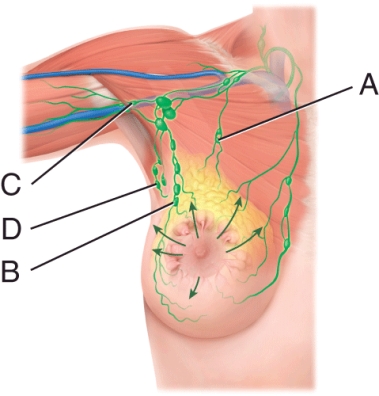
a) A
b) B
c) C
d) D

a) A
b) B
c) C
d) D

Unlock Deck
Unlock for access to all 75 flashcards in this deck.
Unlock Deck
k this deck
62
The lymph nodes of the abdomen are divided into parietal and visceral groups.

Unlock Deck
Unlock for access to all 75 flashcards in this deck.
Unlock Deck
k this deck
63
MALT refers to lymphatic tissue scattered in the lining of the
A) respiratory tract
B) urinary tract
C) gastrointestinal tract
D) All of these choices
A) respiratory tract
B) urinary tract
C) gastrointestinal tract
D) All of these choices

Unlock Deck
Unlock for access to all 75 flashcards in this deck.
Unlock Deck
k this deck
64
Which of the following nodes belong to the largest group of nodes in the neck forming a chain extending from the base of the skull to the root of the neck? 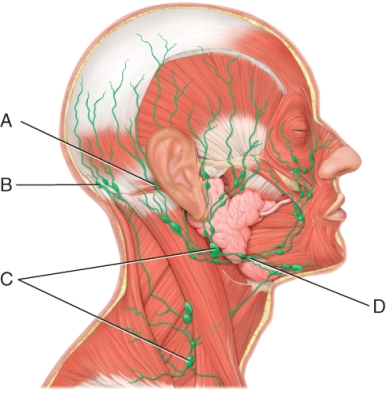
A) A
B) B
C) C
D) D

A) A
B) B
C) C
D) D

Unlock Deck
Unlock for access to all 75 flashcards in this deck.
Unlock Deck
k this deck
65
The elderly tend to respond poorly to vaccines because of decreased production of autoantibodies.

Unlock Deck
Unlock for access to all 75 flashcards in this deck.
Unlock Deck
k this deck
66
The principal lymphatic trunks include all of the following EXCEPT the
A) jugular
B) subclavian
C) bronchomediastinal
D) cervical
A) jugular
B) subclavian
C) bronchomediastinal
D) cervical

Unlock Deck
Unlock for access to all 75 flashcards in this deck.
Unlock Deck
k this deck
67
Which of the following lymph nodes is responsible for draining the chin, lips, nose, nasal cavity, cheeks, gums, inferior surface of palate, and anterior portion of tongue? 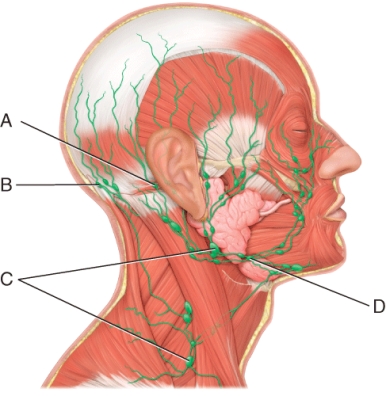
A) A
B) B
C) C
D) D

A) A
B) B
C) C
D) D

Unlock Deck
Unlock for access to all 75 flashcards in this deck.
Unlock Deck
k this deck
68
Which two principal lymphatic trunks join to form the cisterna chyli?
A) jugular and cervical
B) intestinal and lumbar
C) bronchomediastinal and subclavian
D) lumbar and bronchomediastinal
A) jugular and cervical
B) intestinal and lumbar
C) bronchomediastinal and subclavian
D) lumbar and bronchomediastinal

Unlock Deck
Unlock for access to all 75 flashcards in this deck.
Unlock Deck
k this deck
69
Lymphatic vessels develop from lymphatic sacs, which arise from developing veins, which are derived from mesoderm.

Unlock Deck
Unlock for access to all 75 flashcards in this deck.
Unlock Deck
k this deck
70
Afferent lymphatic vessels have valves that open away from a lymph node so that they direct the flow of lymph out of the node.

Unlock Deck
Unlock for access to all 75 flashcards in this deck.
Unlock Deck
k this deck
71
Which of the following is NOT one of the tonsils which form a tonsillar (Waldeyer's) ring at the junction of the oral cavity and oropharynx and at the junction of the nasal cavity and nasopharynx?
A) palatine tonsils
B) pharyngeal (adenoid) tonsil
C) cervical tonsils
D) lingual tonsils
A) palatine tonsils
B) pharyngeal (adenoid) tonsil
C) cervical tonsils
D) lingual tonsils

Unlock Deck
Unlock for access to all 75 flashcards in this deck.
Unlock Deck
k this deck
72
This structure serves as the beginning of the _____. 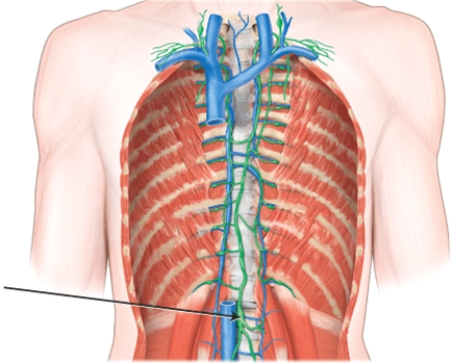
A) azygos vein
B) thoracic duct
C) left bronchomediastinal trunk
D) right lymphatic duct

A) azygos vein
B) thoracic duct
C) left bronchomediastinal trunk
D) right lymphatic duct

Unlock Deck
Unlock for access to all 75 flashcards in this deck.
Unlock Deck
k this deck
73
The parenchyma (functional portion) of this organ is comprised of _____ (lymphatic tissue) and _____ (blood-filled sinuses). 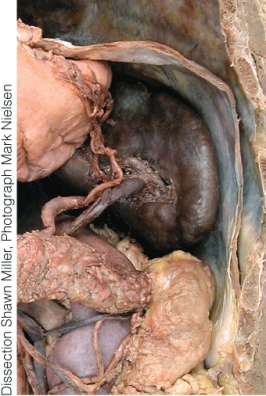


Unlock Deck
Unlock for access to all 75 flashcards in this deck.
Unlock Deck
k this deck
74
HIV is a retrovirus, which means that its genetic information is carried in _____.

Unlock Deck
Unlock for access to all 75 flashcards in this deck.
Unlock Deck
k this deck
75
Extensions of the thymus capsule called _____ penetrate inward dividing each lobe of the gland into lobules.
A) trabeculae
B) white pulp
C) red pulp
D) lacteals
A) trabeculae
B) white pulp
C) red pulp
D) lacteals

Unlock Deck
Unlock for access to all 75 flashcards in this deck.
Unlock Deck
k this deck



